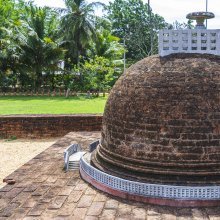Vedi, Vedī, Vedin: 36 definitions
Introduction:
Vedi means something in Buddhism, Pali, Hinduism, Sanskrit, the history of ancient India, Marathi, Hindi. If you want to know the exact meaning, history, etymology or English translation of this term then check out the descriptions on this page. Add your comment or reference to a book if you want to contribute to this summary article.
Images (photo gallery)
In Hinduism
Purana and Itihasa (epic history)
Source: archive.org: Puranic EncyclopediaVedī (वेदी).—Wife of Brahmā. (Mahābhārata Udyoga Parva, Chapter 117, Verse 10).
Source: archive.org: Shiva Purana - English TranslationVedī (वेदी) refers to an “altar”, according to the Śivapurāṇa 2.3.22 (“Description of Pārvatī’s penance”).—Accordingly, after Menā spoke to Pārvatī: “[...] Neatly cleaning the ground, the beautiful lady built the altar [i.e., vedī]. Then the penance, difficult to be performed even by the sages, was begun. Suppressing her sense-organs with her mind, she started the great penance in a place within the proximity. In the summer she kept a perpetually blazing fire all round and remaining within continued muttering the mantra. [...]”.
Source: Cologne Digital Sanskrit Dictionaries: The Purana Index1a) Vedi (वेदि).—A river served by the Siddhas.*
- * Brahmāṇḍa-purāṇa III. 13. 81.
1b) One of the ten pīṭhas for images, oblong; unfit for installing lingas; this gives abundant riches.*
- * Matsya-purāṇa 262. 6, 17.
1c) (also Veditalam) the place of the fire altar in the sacrifice.*
- * Vāyu-purāṇa 69. 60; 97. 25.
Vedī (वेदी) refers to the name of a Tīrtha (pilgrim’s destination) mentioned in the Mahābhārata (cf. III.81). Note: The Mahābhārata (mentioning Vedī) is a Sanskrit epic poem consisting of 100,000 ślokas (metrical verses) and is over 2000 years old.

The Purana (पुराण, purāṇas) refers to Sanskrit literature preserving ancient India’s vast cultural history, including historical legends, religious ceremonies, various arts and sciences. The eighteen mahapuranas total over 400,000 shlokas (metrical couplets) and date to at least several centuries BCE.
Vastushastra (architecture)
Source: Wisdom Library: Vāstu-śāstraVedi (वेदि) refers to “sacrificial altar” to be build by the sthapati, in the center of the yāgamaṇḍapa, according to the Mānasāra chapter 70 (“chiselling the eyes of the image”).
Source: Google Books: Indian Temple Architecture: Form and TransformationVedī (वेदी).—A type of moulding common to both the prastara (parapet) and adhiṣṭhana (plinth);—Vedī or vedikā means ‘railing’, and the moulding occurs, like a vestigial balustrade, as a course above the floor slab level and the plinth proper. The vedī moulding in parapets (prastara) is also derived from a railing. Although this origin is not evident in examples from Karnataka, it becomes clear if the parapet details of the Pallava monuments at Mahabalipuram are compared with the images of timber and thatch buildings shown in earlier Buddhist reliefs.
Vedī also means altar, another connotation of the table-like moulding, particularly as ‘high altar’ at the summit. The coincidence of railing and altar brings to mind the railed harmikā, the ‘high altar’ of a stūpa.
Source: Shodhganga: Temples of Salem region Up to 1336 ADVedi (वेदि) is a platform to support the grīva and the śikhara. Vedi is constructed like any other constructions in stone or brick and mortar, above the final tala of the prāsāda. Vedi, on plan, always corresponds to the plan of the grīva and the śikhara. The body of the vedi may have bhittipādas and the top of the vedi will have a stringcourse or a vājana.
Source: Knowledge Traditions & Practices of India: Architecture (1): Early and Classical ArchitectureVedi (वेदि) refers to a “Vedic sacrificial altar”, a concept defined within the ancient Indian “science of architecture” (vāstuvidyā).—The origin of Indian temple architecture can be traced to Vedic times. The square shape of the vedi (Vedic sacrificial altar) inspired the basic design of temples. The Indian shrine depicted in early bas-reliefs at Bharhut, Sanchi, Mathura and Amravati, has a small square altar, often enclosed by a vedikā (square railing) and shaded by a tree or a chattra (parasol).
Source: OpenEdition books: Architectural terms contained in Ajitāgama and RauravāgamaVedī (वेदी) [or vedikā] refers to “- 1. bahut (separating two levels of the elevation) §§ 3.6, 8, 12, 15, 25, 26; 4.12. - 2. bahut (raising an enclosure wall) (Aj) § 5.8. - 3. support of dhvajadaṇḍa § 5.12. - 4. central platform of a sacrificial pavilion (or other) §§ 3.3, 6, 12; 4.17, 24, 25, 28, 29. - 5. band (molding) § 3.6. - 6. see snānavedī.”.—(For paragraphs cf. Les enseignements architecturaux de l'Ajitāgama et du Rauravāgama by Bruno Dagens)

Vastushastra (वास्तुशास्त्र, vāstuśāstra) refers to the ancient Indian science (shastra) of architecture (vastu), dealing with topics such architecture, sculpture, town-building, fort building and various other constructions. Vastu also deals with the philosophy of the architectural relation with the cosmic universe.
Shaivism (Shaiva philosophy)
Source: Brill: Śaivism and the Tantric TraditionsVedin (वेदिन्) refers to “those who know (the Tantras)”, according to the Jayadrathayāmala, Ṣaṭka 1 verse 13.3–18::—Accordingly, “And that [initiation] is either a Samayadīkṣā or Nirvāṇādīkṣā, divided into two because it has two natures. Now the Samayadīkṣā is further twofold because of a difference in the result. [The first] bestows adhikāra [and] follows the practices of jñāna and yoga, [the second] destroys the latent impressions of that [soul?] and bestows a state of eternal pervasion [with the deity]. [That is known] by the firm ones who know the Tantras (tantra-vedin). [...]

Shaiva (शैव, śaiva) or Shaivism (śaivism) represents a tradition of Hinduism worshiping Shiva as the supreme being. Closely related to Shaktism, Shaiva literature includes a range of scriptures, including Tantras, while the root of this tradition may be traced back to the ancient Vedas.
Sports, Arts and Entertainment (wordly enjoyments)
Source: archive.org: Syainika Sastra of Rudradeva with English Translation (art)Vedi (वेदि) refers to a “platform (in a garden)” (suitable for keeping hawks), according to the Śyainika-śāstra: a Sanskrit treatise dealing with the divisions and benefits of Hunting and Hawking, written by Rājā Rudradeva (or Candradeva) in possibly the 13th century.—Accordingly, [while discussing the treatment of hawks]: “[...] [Hawks] should be kept on a platform (vedi) in a garden, well-guarded by porters and cooled with the water from artificial streams shaded with tall trees standing close to each other, where the fierce rays of the sun cannot penetrate. [...]”.

This section covers the skills and profiencies of the Kalas (“performing arts”) and Shastras (“sciences”) involving ancient Indian traditions of sports, games, arts, entertainment, love-making and other means of wordly enjoyments. Traditionally these topics were dealt with in Sanskrit treatises explaing the philosophy and the justification of enjoying the pleasures of the senses.
General definition (in Hinduism)
Source: Shodhganga: Elements of Art and Architecture in the Trtiyakhanda of the Visnudharmottarapurana (h)Vedī (वेदी) refers to the “sacrificial ground” (i.e., “a ground for offering materials specifically to God”).—In the Śatapathabrāhmaṇa it is stated that by worshiping fire in the Vedic age, the devotees or the sages obtained saṃvīd i.e., the entire earth and as because they were able to obtain this entire earth by it, therefore the, sacrificial ground is called vedī. According to the Taittirīyabrāhmaṇa, also the earth itself is regarded as altar. Thus the concept of the vedī or a ground for offering materials specifically to God of worship emerged in the Vedic era. Again after making the vedī, the concept of idol worship came into existence.
In Buddhism
Tibetan Buddhism (Vajrayana or tantric Buddhism)
Source: MDPI Books: The Ocean of HeroesVedī (वेदी) refers to “altars”, according to the 10th-century Ḍākārṇava-tantra: one of the last Tibetan Tantric scriptures belonging to the Buddhist Saṃvara tradition consisting of 51 chapters.—Accordingly, [while describing the Merit Circle (guṇacakra)]: “[...] He should make [mantras of all Yoginīs] on all circles [in this manner]. Outside that, he should give a circle, [on which there are] two lines [colored] black and dark blue. Gates, arched doorways, and altars (vedī) are [on the circle], adorned with garlands of pearls and half-garlands of pearls. [...] Two colors should be evenly assigned [to them] in accordance with the [directions they] face, respectively. [...]”.

Tibetan Buddhism includes schools such as Nyingma, Kadampa, Kagyu and Gelug. Their primary canon of literature is divided in two broad categories: The Kangyur, which consists of Buddha’s words, and the Tengyur, which includes commentaries from various sources. Esotericism and tantra techniques (vajrayāna) are collected indepently.
India history and geography
Source: Cologne Digital Sanskrit Dictionaries: Indian Epigraphical GlossaryVedi.—(EI 32), a seat; also a raised platform (cf. vedikā). See JBRS, Vol. XXXIX, Parts 1-2, pp. 43-44, 47; Ep. Ind., Vol. XXXV, p. 192. Note: vedi is defined in the “Indian epigraphical glossary” as it can be found on ancient inscriptions commonly written in Sanskrit, Prakrit or Dravidian languages.
Source: Singhi Jain Series: Ratnaprabha-suri’s Kuvalayamala-katha (history)Vedī (वेदी) refers to the “fire altar”, according to Uddyotanasūri in his 8th-century Kuvalayamālā (a Prakrit Campū, similar to Kāvya poetry).—The Kuvalayamala (779 A.D.) is full of cultural material which gains in value because of the firm date of its composition. [...] Page 170.21 f.: Twenty-four items are mentioned in connection with the marriage of Kuvalayamālā, [for instance, colouring of the fire altar (vedī)], [...].

The history of India traces the identification of countries, villages, towns and other regions of India, as well as mythology, zoology, royal dynasties, rulers, tribes, local festivities and traditions and regional languages. Ancient India enjoyed religious freedom and encourages the path of Dharma, a concept common to Buddhism, Hinduism, and Jainism.
Languages of India and abroad
Pali-English dictionary
Source: BuddhaSasana: Concise Pali-English Dictionaryvedi : (aor. of vidati) knows. || vedī (f.) a platform; a railing.
Source: Sutta: The Pali Text Society's Pali-English DictionaryVedi, & Vedī (f.) (Vedic vedi sacrificial bench) ledge, cornice, rail Mhvs 32, 5; 35, 2; 36, 52 (pāsāṇa°); 36, 103; Vv 8416 (=vedikā VvA. 346).—See on term Dial. II. 210; Mhvs. tsrln 220, 296. Cp. vedikā & velli. (Page 648)

Pali is the language of the Tipiṭaka, which is the sacred canon of Theravāda Buddhism and contains much of the Buddha’s speech. Closeley related to Sanskrit, both languages are used interchangeably between religions.
Marathi-English dictionary
Source: DDSA: The Molesworth Marathi and English Dictionaryvēdi (वेदि).—, or vēdikā f S A plat or raised ground on which sacrifices or oblations are offered. 2 A border around the kuṇḍa (the pit) or the level area of a place of sacrifice. 3 A defined space (as in the yard of a temple &c.) on which a raised mass is made, serving as an altar; a seat for the vessels used in oblations &c; a stand for idols to be placed and worshiped.
--- OR ---
vēdī (वेदी).—, or vēdikā f S A plat or raised ground on which sacrifices or oblations are offered. 2 A border around the kuṇḍa (the pit) or the level area of a place of sacrifice. 3 A defined space (as in the yard of a temple &c.) on which a raised mass is made, serving as an altar; a seat for the vessels used in oblations &c; a stand for idols to be placed and worshiped.
Source: DDSA: The Aryabhusan school dictionary, Marathi-Englishvēdi (वेदि).—f An altar.
--- OR ---
vēdī (वेदी).—f An altar.
Marathi is an Indo-European language having over 70 million native speakers people in (predominantly) Maharashtra India. Marathi, like many other Indo-Aryan languages, evolved from early forms of Prakrit, which itself is a subset of Sanskrit, one of the most ancient languages of the world.
Sanskrit dictionary
Source: DDSA: The practical Sanskrit-English dictionaryVedin (वेदिन्).—a. [vid-ṇini]
1) Knowing; as in कृतवेदिन् (kṛtavedin).
2) Marrying. -m.
1) A knower.
2) A teacher.
3) A learned Brāhmaṇa.
4) An epithet of Brahman.
Source: DDSA: The practical Sanskrit-English dictionaryVedi (वेदि).—[vid-in] A learned man, sage; Paṇḍita.
-diḥ, -dī f.
1) An altar, especially one prepared for a sacrifice; उर एव वेदिः (ura eva vediḥ) Ch. Up.5.18.2; अमी वेदिं परितः क्लृप्त- धिष्ण्याः (amī vediṃ paritaḥ klṛpta- dhiṣṇyāḥ) (vahvayaḥ) Ś.4.8.
2) An altar of a particular shape, the middle points of which come very close to each other; मध्येन सा वेदिविलग्नमध्या (madhyena sā vedivilagnamadhyā) Kumārasambhava 1.39; (some propose to take vedi in this passage as meaning 'a sealring').
3) A quadrangular spot in the court-yard of a temple or palace; विमानं नवमुद्वेदि चतुःस्तम्भप्रतिष्ठितम् (vimānaṃ navamudvedi catuḥstambhapratiṣṭhitam) (kalpayāmāsuḥ) R.17.9.
4) A seal-ring.
5) Name of Sarasvatī.
6) A tract or region.
Derivable forms: vediḥ (वेदिः).
Source: Cologne Digital Sanskrit Dictionaries: Shabda-Sagara Sanskrit-English DictionaryVedi (वेदि).—f. (-diḥ-dī) 1. Ground for placing the vessels used at an oblation, or for binding the victim, or lighting the sacrificial fire; it is more or less raised and of various shapes; an alter, &c. 2. A quadrangular spot in the court-yard of a temple or palace, usually furnished with a raised floor or seat, and covered with a roof supported by pillars: see vitarddi. 3. A seal-ring. m.
(-diḥ) A Pandit, a teacher. f.
(-diḥ) A name of Saraswati. E. vid to know, &c., Unadi aff. in, and ṅīṣ optionally added in the fem. form.
Source: Cologne Digital Sanskrit Dictionaries: Shabda-Sagara Sanskrit-English DictionaryVedin (वेदिन्).—mfn. (-dī-dinī-di) Who or what knows. m. (-dī) 1. A Pandit, a learned Brahman, a teacher. 2. Brahma. n. (-di) A plant, (Cissampelos hexandra.) E. vid to know, aff. ṇini or ghinuṇ aff.
Source: Cologne Digital Sanskrit Dictionaries: Benfey Sanskrit-English DictionaryVedi (वेदि).—vedī [I.] and vedī, f. 1. Ground prepared for sacrifice, an altar, [Śākuntala, (ed. Böhtlingk.)] 31, 6; [Nala] 1, 9; [Rāmāyaṇa] 1, 21, 5. 2. A quadrangular spot in the court-yard of a temple or palace, usually furnished with a raised floor or seat, and covered with a roof supported by pillars, [Bhāgavata-Purāṇa, (ed. Burnouf.)] 4, 25, 16. 3. A bench, ib. 3, 23, 17. 4. A seal-ring. Ii. vedi vedi, 1. m. A teacher. 2. f. Sarasvatī.
Source: Cologne Digital Sanskrit Dictionaries: Benfey Sanskrit-English DictionaryVedin (वेदिन्).—i. e. vid and veda, + in, I. adj. 1. Knowing, acquainted with, [Mānavadharmaśāstra] 1, 97. 2. Marrying, [Mānavadharmaśāstra] 3, 16. Ii. m. 1. Brahman. 2. A learned Brāhmaṇa, a teacher. Iii. m. A plant, Cissampelos hexandra.
Source: Cologne Digital Sanskrit Dictionaries: Cappeller Sanskrit-English DictionaryVedi (वेदि).—[feminine] the sacrificial bed or altar (excavated in the ground and covered with grass or straw); i.[grammar] support, pedestal, bench.
--- OR ---
Vedī (वेदी).—[feminine] the sacrificial bed or altar (excavated in the ground and covered with grass or straw); i.[grammar] support, pedestal, bench.
Source: Cologne Digital Sanskrit Dictionaries: Cappeller Sanskrit-English DictionaryVedin (वेदिन्).—1. [adjective] knowing or making known (—°).
--- OR ---
Vedin (वेदिन्).—2. [adjective] marrying (—°).
Source: Cologne Digital Sanskrit Dictionaries: Monier-Williams Sanskrit-English Dictionary1) Vedi (वेदि):—[from veda] 1. vedi m. a wise man, teacher, Paṇḍit, [cf. Lexicographers, esp. such as amarasiṃha, halāyudha, hemacandra, etc.]
2) [v.s. ...] f. knowledge, science (See a-v)
3) [v.s. ...] a seal-ring (also dikā), [cf. Lexicographers, esp. such as amarasiṃha, halāyudha, hemacandra, etc.]
4) Vedī (वेदी):—[from vedi > veda] a f. Name of Sarasvatī, [cf. Lexicographers, esp. such as amarasiṃha, halāyudha, hemacandra, etc.]
5) Vedi (वेदि):—[from veda] 2. vedi in [compound] for 1. vedin.
6) [from veda] 3. vedi f. (later also vedī; for 1. 2. See [column]2) an elevated (or according to some excavated) piece of ground serving for a sacrificial altar (generally strewed with Kuśa grass, and having receptacles for the sacrificial fire; it is more or less raised and of various shapes, but usually narrow in the middle, on which account the female waist is often compared to it), [Ṛg-veda] etc. etc.
7) [v.s. ...] the space between the supposed spokes of a wheel-shaped altar, [Śulba-sūtra]
8) [v.s. ...] a kind of covered verandah or balcony in a court-yard (shaped like a Vedi and prepared for weddings etc. = vitardi), [Kāvya literature; Kathāsaritsāgara]
9) [v.s. ...] a stand, basis, pedestal, bench, [Mahābhārata; Kāvya literature] etc.
10) [v.s. ...] Name of a Tīrtha, [Mahābhārata] (only ī)
11) [v.s. ...] n. a species of plant (= ambaṣṭha),
12) Vedī (वेदी):—[from veda] b See under 1. and 3. vedi.
Source: Cologne Digital Sanskrit Dictionaries: Monier-Williams Sanskrit-English Dictionary1) Vedin (वेदिन्):—[from veda] 1. vedin mfn. (for 2. 3. See [column]3) knowing, acquainted with or versed in (ifc.), [Manu-smṛti; Mahābhārata] etc. (cf. sarva-v)
2) [v.s. ...] feeling, perceiving, [Mahābhārata; Purāṇa]
3) [v.s. ...] announcing, proclaiming, [Mahābhārata; Rāmāyaṇa]
4) [v.s. ...] m. Name of Brahmā, [cf. Lexicographers, esp. such as amarasiṃha, halāyudha, hemacandra, etc.]
5) [from veda] 2. vedin mfn. marrying (See śūdrā-v).
6) [from veda] 3. vedin n. a species of plant (= ambaṣṭha), [cf. Lexicographers, esp. such as amarasiṃha, halāyudha, hemacandra, etc.] (cf. 2. vedi).
Source: Cologne Digital Sanskrit Dictionaries: Yates Sanskrit-English DictionaryVedi (वेदि):—[(diḥ-dī)] 2. 3. f. An altar; seal ring. m. A pandit. f. (diḥ) Saraswatī.
Source: Cologne Digital Sanskrit Dictionaries: Yates Sanskrit-English DictionaryVedin (वेदिन्):—[(dī-dinī-di) m.] A pandit; Brahmā. n. A plant (Cissampelos).
Source: DDSA: Paia-sadda-mahannavo; a comprehensive Prakrit Hindi dictionary (S)Vedi (वेदि) in the Sanskrit language is related to the Prakrit word: Vei.
[Sanskrit to German]
Sanskrit, also spelled संस्कृतम् (saṃskṛtam), is an ancient language of India commonly seen as the grandmother of the Indo-European language family (even English!). Closely allied with Prakrit and Pali, Sanskrit is more exhaustive in both grammar and terms and has the most extensive collection of literature in the world, greatly surpassing its sister-languages Greek and Latin.
Hindi dictionary
Source: DDSA: A practical Hindi-English dictionaryVedī (वेदी):—(nf) an altar, a platform; terrace; a suffix used in the sense of a knower or scholar of the Vedas (as [caturvedī, trivedī]).
...
Kannada-English dictionary
Source: Alar: Kannada-English corpusVēdi (ವೇದಿ):—[noun] a learned man; a scholar.
--- OR ---
Vēdi (ವೇದಿ):—
1) [noun] a plot of land prepared for conducting a religious sacrifice on.
2) [noun] a raised flooring or platform for performers, speakers, etc.; a stage.
Kannada is a Dravidian language (as opposed to the Indo-European language family) mainly spoken in the southwestern region of India.
See also (Relevant definitions)
Starts with (+96): Veda, Vedi Halada, Vedi-babul, Vedibabool, Vedibhadra, Vedibhajana, Vedibhumi, Vedic action, Vedic age, Vedic Knowledge, Vedic Mantra, Vedic path, Vedic procedure, Vedic religion, Vedic rite, Vedic ritual, Vedic sacrifice, Vedic text, Vediga, Vedija.
Ends with (+79): Acanaveti, Acaravedi, Acharavedi, Agamavedi, Akhilavedi, Amdavedi, Annaveti, Antaravedi, Antaruveti, Antarvedi, Antarveti, Anuvedi, Asamvedi, Avedi, Ayurvedi, Bahirvedi, Brahmavedi, Cakattiraveti, Camaveti, Captaveti.
Full-text (+260): Antarvedi, Vedija, Kanyavedin, Bahirvedi, Antaravedi, Vedisa, Mahavedi, Sarvavedin, Ratrivedin, Nishavedin, Bahirvedika, Ayurvedin, Kritavedin, Avedi, Vedita, Natyavedi, Vedimati, Vedimekhala, Karunavedita, Pashuvedi.
Relevant text
Search found 77 books and stories containing Vedi, Vedī, Vēdī, Vēdi, Vedin; (plurals include: Vedis, Vedīs, Vēdīs, Vēdis, Vedins). You can also click to the full overview containing English textual excerpts. Below are direct links for the most relevant articles:
Rig Veda (translation and commentary) (by H. H. Wilson)
Satapatha-brahmana (by Julius Eggeling)
Kāṇḍa XII, adhyāya 7, brāhmaṇa 3 < [Twelfth Kāṇḍa]
Kāṇḍa XII, adhyāya 8, brāhmaṇa 1 < [Twelfth Kāṇḍa]
Kāṇḍa X, adhyāya 2, brāhmaṇa 3 < [Tenth Kāṇḍa]
Vishnudharmottara Purana (Art and Architecture) (by Bhagyashree Sarma)
1. Origin and Development of Temple building < [Chapter 4 - Temple Building]
The Skanda Purana (by G. V. Tagare)
Chapter 77 - Importance of Harāśraya Vedikā < [Section 1 - Tīrtha-māhātmya]
Chapter 267 - Importance of Tulāpuruṣadāna (Tulāpuruṣa-dāna) < [Section 1 - Tīrtha-māhātmya]
Chapter 1 - The Greatness of Mahākālavana < [Section 1 - Avantīkṣetra-māhātmya]
The Agnistoma Somayaga in the Shukla Yajurveda (by Madan Haloi)
Part 4.8: Preparation of the Dhiṣṇyas < [Chapter 4 - The Agniṣṭoma Ritual]
Part 3.2: Construction of the Uttaravedī < [Chapter 4 - The Agniṣṭoma Ritual]
Part 4.1: Carrying forward of the Āhavanīya fire < [Chapter 4 - The Agniṣṭoma Ritual]
Related products




